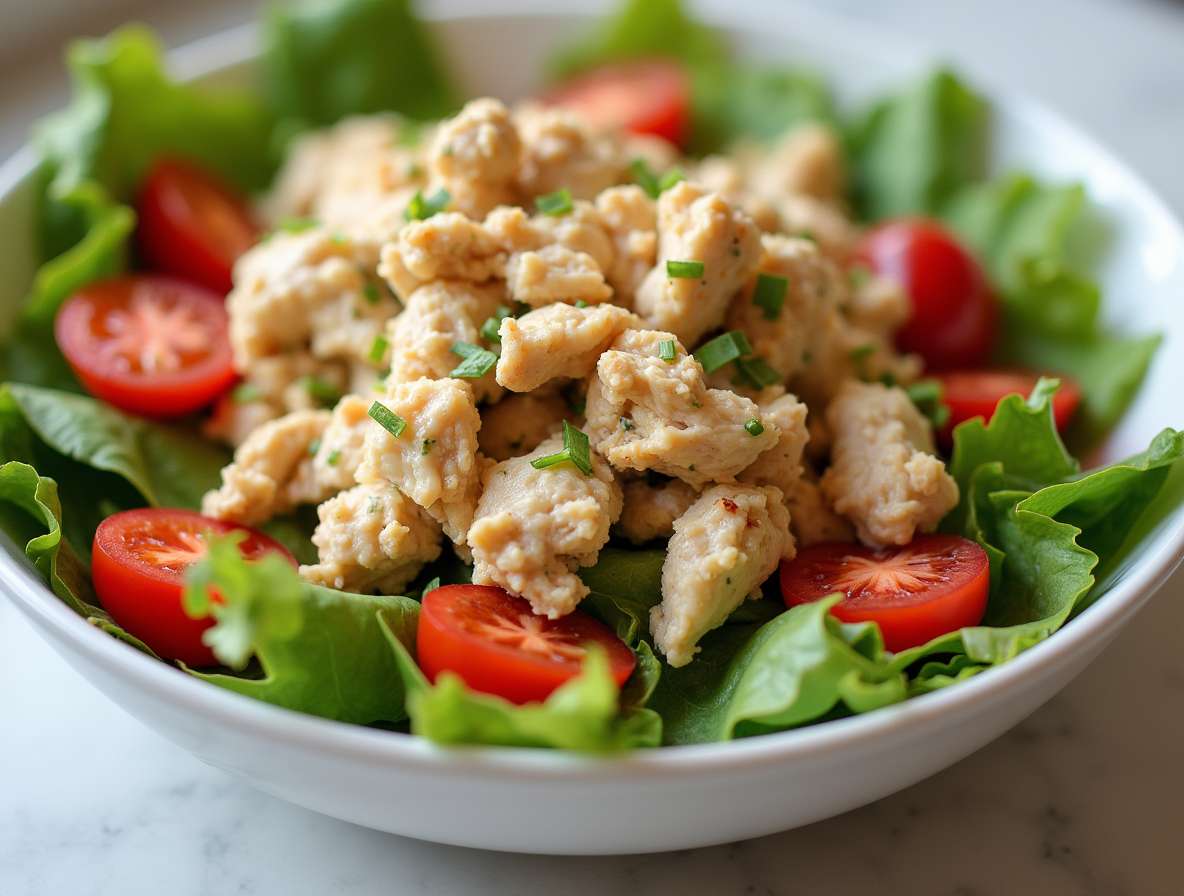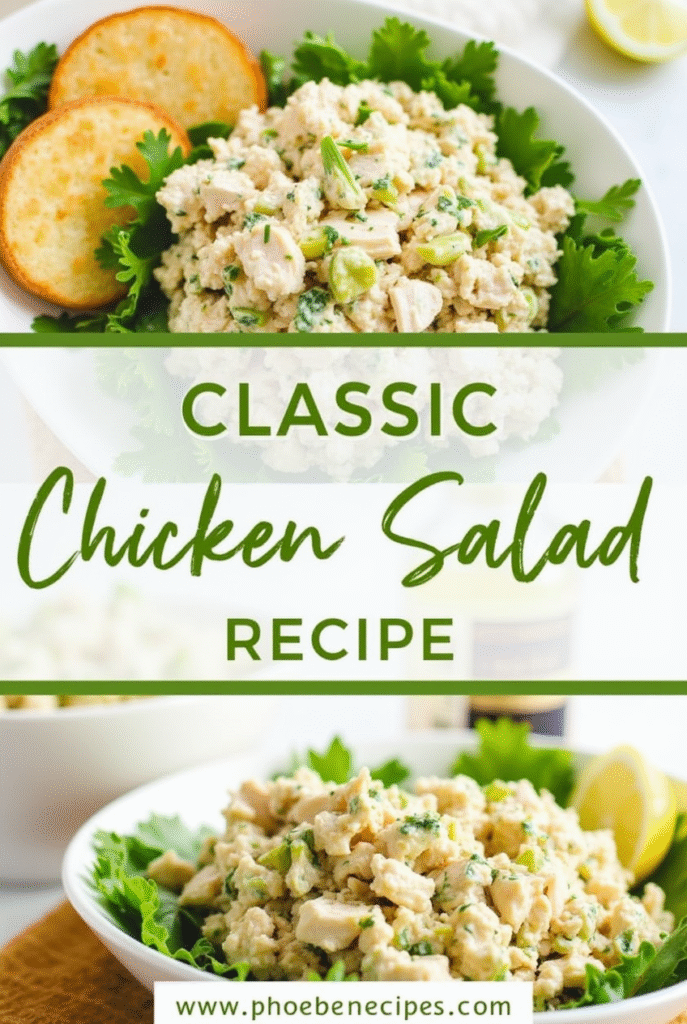How to Make Chicken Salad: A Foolproof Family Recipe (Never Dry!)
How to make chicken salad is surprisingly simple – you can prepare this classic dish in just 15 minutes with only a few basic ingredients. We’ve been using this foolproof family recipe for years, and it never disappoints when we need a quick, satisfying meal.
This easy chicken salad recipe yields about 3½ cups (6 servings of ½ cup each) and can be customized with various add-ins like grapes or nuts. The traditional chicken salad recipe calls for 4½ cups of cooked shredded chicken, which can come from poached, grilled, or rotisserie chicken – whatever works best for you! Additionally, our classic chicken salad recipe is perfect for make-ahead lunches, lasting about 4 days in the refrigerator. You can certainly make it lighter by substituting Greek yogurt for some or all of the mayonnaise, particularly if you’re watching your calorie intake.
Choosing the Right Ingredients for a Classic Chicken Salad
The foundation of any memorable chicken salad lies in selecting the right ingredients. Creating the perfect balance of flavors and textures starts with understanding your options for each component.
Best chicken options: rotisserie, poached, or grilled
Rotisserie chicken stands out as an excellent choice due to its convenience and flavor. These pre-seasoned birds are cooked with bones and skin intact, resulting in exceptionally juicy, flavorful meat that’s ready to use. Simply remove the skin and bones before chopping the meat into bite-sized pieces.
Poached chicken produces beautifully tender results that shine in chicken salad. This gentle cooking method involves simmering chicken in liquid with aromatics like lemon, parsley, bay leaves, and peppercorns. The key is maintaining a gentle simmer – never a rapid boil – to ensure juicy results.
Breast meat generally works better for chicken salad than dark meat. As one chef explains, “Since chicken salad is served cold, chicken breast is preferable—it’s got a much more pleasant mouthfeel than dark meat when eaten at lower temps”.
Creamy base: mayo, Greek yogurt, or sour cream
Mayo traditionally serves as the binding agent in classic chicken salad, with brands like Hellmann’s, Duke’s, or Kewpie being popular choices. However, many chefs now recommend a combination approach.
Greek yogurt has emerged as a fantastic mayo alternative. “I often add a combination of Greek yogurt and mayo,” notes one culinary expert. This blend provides creaminess with added protein and reduced calories. For best results, use full-fat or 2% Greek yogurt rather than non-fat varieties, which can make salads watery.
Sour cream adds delightful tanginess and works well blended with mayo or yogurt. The ideal ratio depends on your preference – try starting with equal parts mayo and yogurt or sour cream.
Crunchy and fresh: celery, onions, and herbs
Celery provides essential crunch in chicken salad. Dice it finely for better texture distribution or even grate it for a more subtle presence.
Onions add brightness in various forms. Red onions offer a peppery, slightly sweet flavor with gorgeous color. White onions provide sharper flavor, while scallions deliver a milder bite. Add them gradually to avoid overwhelming the salad.
Fresh herbs elevate chicken salad tremendously. Dill and parsley are classic choices, while tarragon adds distinctive anise notes. Chives blend beautifully with the creamy base. Herbs should be finely chopped and added to taste.
Optional add-ins: grapes, apples, nuts, and more
Fresh fruits introduce delightful sweetness and texture:
- Halved red grapes provide juicy bursts of flavor
- Diced apples add crispness and subtle sweetness
- Dried cranberries or golden raisins offer concentrated sweetness
Toasted nuts contribute wonderful crunch and depth. Almonds, walnuts, pecans, and cashews are all excellent options. Toasting them briefly in a dry skillet enhances their flavor significantly.
Other popular add-ins include hard-boiled eggs for richness, diced pickles for tang, and cucumber for extra freshness.
Remember that chicken salad is endlessly customizable – start with the basics and experiment until you find your perfect combination.
Step-by-Step: How to Make Chicken Salad at Home
Creating your own chicken salad at home involves a few simple techniques that guarantee perfect results every time. Let’s break down the process into manageable steps that will help you master this versatile dish.
1. Prep your chicken and vegetables
Initially, you’ll need properly cooked chicken. For the juiciest results, poach chicken breasts by placing them in a pot with broth and salt, bringing to a boil, then reducing to a simmer for about 10 minutes until they reach an internal temperature of 165°F. Alternatively, use rotisserie chicken for convenience. Allow the chicken to cool completely before handling.
Once cooled, either dice your chicken into uniform cubes or shred it by hand. Many chefs prefer shredding as it creates a better texture and helps the chicken retain moisture.
Meanwhile, finely dice your celery, onions, and any other vegetables you’re including. Aim for small, uniform pieces that will distribute evenly throughout the salad.
2. Mix the dressing separately
In a medium bowl, combine your creamy base ingredients first. Whisk together mayonnaise, Greek yogurt or sour cream until smooth. Next, add lemon juice, mustard, salt, and pepper to taste. This separate mixing ensures all flavors are evenly distributed before coating the chicken.
For extra flavor, incorporate fresh herbs like dill, parsley, or tarragon at this stage. Taste your dressing and adjust seasonings accordingly – remember that the chicken itself is unseasoned, so your dressing needs enough flavor to carry the dish.
3. Combine and gently fold ingredients
Once your dressing is prepared, add the cooled chicken to it first, gently stirring to coat each piece thoroughly. Afterwards, fold in your diced vegetables and other mix-ins like grapes, nuts, or apples.
Use a folding motion rather than aggressive stirring to maintain the texture of your ingredients and prevent the chicken from breaking apart too much.
4. Chill before serving for best flavor
Although technically ready to eat immediately, chicken salad benefits tremendously from resting time. Cover your finished salad and refrigerate for at least one hour, though overnight is ideal. During this time, the flavors meld together beautifully, creating a more cohesive and flavorful result.
The chilling period also allows the dressing to slightly firm up, making for better texture when serving on sandwiches or alongside greens.
How to Avoid Dry Chicken Salad Every Time
Dry chicken salad can quickly ruin your meal experience, but a few simple techniques can ensure perfectly moist results every time. Furthermore, these moisture-preserving methods will elevate your homemade chicken salad recipe from good to exceptional.
Use juicy chicken cuts
Bone-in, skin-on chicken breasts are your best starting point for a never-dry chicken salad. Specifically, these cuts provide natural insulation during cooking, resulting in juicier meat. “The skin and bones act as a buffer, insulating the delicate breast meat” when cooking at higher temperatures.
For guaranteed moisture, consider using chicken thighs instead of breasts. As one expert notes, “If you’re at all worried about your chicken dinner being dry, skip the breast in favor of chicken thighs because they are practically foolproof”.
Add moisture with broth or lemon juice
Rescuing already-dry chicken is possible with a simple technique. Pour a few tablespoons of chicken broth over shredded chicken while warming it slightly. The stock adds just enough moisture to revitalize the meat before mixing with mayonnaise.
In fact, some chefs deliberately add a little chicken broth to their finished salad to keep it moist without needing extra mayo. A squeeze of fresh lemon juice serves double duty – adding both moisture and brightness.
Balance mayo with yogurt or sour cream
The creamy base plays a crucial role in preventing dryness. Consider these ratios:
- Half mayo, half Greek yogurt for balanced flavor and moisture
- One-third yogurt to two-thirds mayo as a starting point
- For protein boost: 1/3 to 1/2 cup Greek yogurt with just 1-2 tablespoons mayo
Greek yogurt prevents the heavy mayo feeling while adding tanginess that complements chicken perfectly. Of course, regular yogurt works too, offering a lighter texture than its Greek counterpart.
Let it rest to absorb flavors
Most importantly, allowing your chicken salad to rest is non-negotiable for perfect texture. “Chicken salad is best served when it’s cold,” notes one expert, recommending refrigeration before serving.
The optimal resting period? At least two hours, but overnight yields the best results. Consequently, the dressing ingredients meld together, enhancing the chicken’s flavor while the cooling process improves texture and moisture retention.
Serving and Storing Your Homemade Chicken Salad
Once your chicken salad is prepared to perfection, the next step is deciding how to serve it and understanding proper storage techniques. This versatile dish offers numerous presentation options that can transform it from a simple lunch to an elegant appetizer.
Best ways to serve: sandwiches, wraps, lettuce cups
Chicken salad shines in various presentations. A classic chicken salad sandwich on toasted bread remains the most popular option, with croissants elevating the experience to another level. For a lighter alternative, try these serving ideas:
- Wrapped in tortillas or flatbreads for a portable meal
- Stuffed into lettuce cups or romaine leaves for a low-carb option
- Scooped onto crackers for easy snacking or appetizers
- Served atop a bed of mixed greens for a complete salad
- Hollowed-out bell peppers or tomatoes as edible vessels
Make-ahead tips for busy weeks
Chicken salad is ideal for meal prep, typically tasting even better the next day. For optimal results:
First, prepare components separately – cook and shred the chicken, then store it without dressing. Next, combine everything except watery vegetables when ready to eat. Store in airtight containers with a date label to track freshness.
How long it lasts in the fridge
According to USDA guidelines, homemade chicken salad should be stored in an airtight container in the refrigerator for no more than 3-4 days. Store-bought versions should follow the manufacturer’s expiration date.
Notably, chicken salad shouldn’t sit at room temperature for more than 2 hours (or 1 hour in environments over 90°F) to prevent bacterial growth. For packed lunches, always include ice packs to maintain safe temperatures.
Can you freeze chicken salad?
While technically possible, freezing chicken salad isn’t generally recommended. The primary issue is mayonnaise, which separates upon thawing, resulting in watery, unappetizing texture. Other ingredients like celery and onions also lose their crispness.
For better results, freeze the chicken component alone with a light coating of olive oil. Upon thawing, add fresh mayonnaise, vegetables, and seasonings to create a new batch with better texture and flavor.
Conclusion
Chicken salad truly stands as one of the most versatile dishes we can prepare at home. Throughout this article, we’ve walked through the essential steps for creating a never-dry chicken salad that your family will request again and again. The beauty of this recipe lies not only in its simplicity but also in its adaptability to your personal preferences.
We’ve discovered that selecting the right chicken makes all the difference. Rotisserie, poached, or grilled options each bring their unique qualities, though bone-in chicken breasts or thighs generally provide the juiciest results. Additionally, finding your perfect creamy base—whether traditional mayonnaise, tangy Greek yogurt, or a combination of both—allows you to control both flavor and nutrition.
The preparation technique matters just as much as the ingredients. Gentle folding rather than aggressive stirring preserves the texture, while allowing adequate chilling time helps flavors meld beautifully together. Most importantly, we’ve shared our family’s tried-and-true tips for avoiding dryness, such as adding a splash of broth or lemon juice when needed.
What makes chicken salad particularly special, though, is its serving versatility. From classic sandwiches on toasted bread to lettuce cups for a lighter option, this dish transforms effortlessly from casual lunch to elegant appetizer. Therefore, mastering this basic recipe opens up countless meal possibilities.
Our family has relied on this foolproof chicken salad recipe for generations because it simply works every time. The next time you find yourself with leftover chicken or need a quick, satisfying meal, remember these straightforward techniques. Your chicken salad will surely become a household favorite, just as it has become ours!
FAQs
Q1. How can I ensure my chicken salad doesn’t turn out dry? To keep your chicken salad moist, use juicy chicken cuts like bone-in, skin-on breasts or thighs. You can also add a splash of chicken broth or lemon juice, and balance mayonnaise with Greek yogurt or sour cream. Letting the salad rest in the refrigerator before serving also helps improve moisture retention.
Q2. What are some creative ways to serve chicken salad? Chicken salad can be served in various ways. Try it in sandwiches, wrapped in tortillas, stuffed into lettuce cups for a low-carb option, scooped onto crackers as an appetizer, or served over a bed of mixed greens. You can also use hollowed-out bell peppers or tomatoes as edible vessels.
Q3. How long does homemade chicken salad last in the refrigerator? Homemade chicken salad should be stored in an airtight container in the refrigerator and consumed within 3-4 days. It’s important not to leave it at room temperature for more than 2 hours (or 1 hour in environments over 90°F) to prevent bacterial growth.
Q4. Can I use Greek yogurt instead of mayonnaise in chicken salad? Yes, you can use Greek yogurt as a healthier alternative to mayonnaise in chicken salad. Many people prefer using a combination of both for balanced flavor and moisture. Try starting with a ratio of half mayo and half Greek yogurt, or one-third yogurt to two-thirds mayo, and adjust to your taste preference.
Q5. What are the best chicken options for making chicken salad? The best chicken options for chicken salad include rotisserie chicken for convenience and flavor, poached chicken for tenderness, or grilled chicken. Breast meat is often preferred for its pleasant texture when served cold. For guaranteed moisture, consider using chicken thighs instead of breasts.


